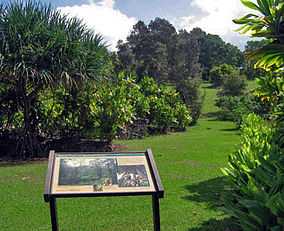Amy B. H. Greenwell Ethnobotanical Garden
| Amy B. H. Greenwell Ethnobotanical Garden | |
|---|---|
|
Interpretive sign at the garden | |
| Location | Island of Hawaiʻi |
| Nearest city | Captain Cook, Hawaii |
| Area | 15 acres (6.1 ha) |
| Established | 1974 |
| Governing body | Bernice P. Bishop Museum |
The Amy B. H. Greenwell Ethnobotanical Garden is a botanical garden near Captain Cook, Hawaii in the Kona District on the Big Island of Hawaii.
Description
The 15-acre (6.1 ha) garden is operated by the Bernice P. Bishop Museum. It is open daily except Christmas Day; in lieu of an admission fee there is a suggested donation, while a modest fee is charged for a guided visit.[1] It is located at 19°29′29″N 155°54′43″W / 19.49139°N 155.91194°WCoordinates: 19°29′29″N 155°54′43″W / 19.49139°N 155.91194°W uphill (mauka) of the Hawaii Belt Road, known as Māmalahoa Highway or Hawaii Route 11, on the western slope of Mauna Loa.
Amy Beatrice Holdsworth Greenwell was born in 1920. Her father was Arthur Leonard Greenwell (1871–1951) and mother was Beatrice Hunt Holdsworth (1891–1981). She was one of the 23 grandchildren of Henry Nicholas Greenwell (1826–1891), who arrived in Hawaii in the 1850s and became a successful merchant and rancher in the area. Her maternal grandparents were merchant Edmund William Holdsworth and Edith Mary Winifred Purvis (1860–1950), who was a distant cousin of William Herbert Purvis, a plant collector on the other side of the island.[2][3]
Greenwell attended Stanford University where she became a member of Gamma Phi Beta and served as a nurse in World War II. After the war she worked with Otto Degener of the New York Botanical Garden on a book series titled Flora Hawaiiensis on Hawiian plants.[4] From 1953 to 1957 she served on a Historical Site Commission for the Territory.[5] She performed archaeology studies of early habitation sites of Hawaii including Ka Lae (South Point), and wrote other books on tropical plants. Later in her lifetime she transformed her property by planting native and Polynesian-introduced plants in the extant Hawaiian agricultural areas. She left the garden to the Bishop Museum on her death in 1974 to be opened to the public.[4]
Today the garden contains over 200 species of endemic, indigenous, and Polynesian-introduced plants that grew in Kona before Captain James Cook's arrival. On certain days it is possible to take a guided tour during which the use and significance of the more important plants are explained. The garden's landscape includes four ecological zones: coastal, dry forest, agricultural, and upland forest. Its native insect house features the Kamehameha butterfly (Vanessa tameamea).[6]
The garden sponsors a farmers' market known as the South Kona green Market on Sundays. It was originally held at the adjacent County of Hawaii park named for Arthur Leonard Greenwell, but is now held a few hundred feet to the southeast at the Kealakekua Ranch Center, named for the former Arthur Leonard Greenwell family ranch which extended up the mountain, overlooking Kealakekua Bay.[7] Across the highway the Kona Coffee Living History Farm run by the Kona Historical Society preserves a Kona coffee farm that was another part of the Greenwell landholdings.[8]
Family tree
| Greenwell family tree | ||||||||||||||||||||||||||||||||||||||||||||||||||||||||||||||||||||||||||||||||||||||||||||||||||||||||||||||||||||||||||||||||||||||||||||||||||||||||||||||||||||||||||||||||||||||||||||||||||||||||||||||||||||||||||||||||||||||||||||||||||||||||||||||||||||||||||||||||||||||||||||||||||||||||||||||||||||||||||||||||||||||||||||||||||||||||||||||||||||||||||||||||||
|---|---|---|---|---|---|---|---|---|---|---|---|---|---|---|---|---|---|---|---|---|---|---|---|---|---|---|---|---|---|---|---|---|---|---|---|---|---|---|---|---|---|---|---|---|---|---|---|---|---|---|---|---|---|---|---|---|---|---|---|---|---|---|---|---|---|---|---|---|---|---|---|---|---|---|---|---|---|---|---|---|---|---|---|---|---|---|---|---|---|---|---|---|---|---|---|---|---|---|---|---|---|---|---|---|---|---|---|---|---|---|---|---|---|---|---|---|---|---|---|---|---|---|---|---|---|---|---|---|---|---|---|---|---|---|---|---|---|---|---|---|---|---|---|---|---|---|---|---|---|---|---|---|---|---|---|---|---|---|---|---|---|---|---|---|---|---|---|---|---|---|---|---|---|---|---|---|---|---|---|---|---|---|---|---|---|---|---|---|---|---|---|---|---|---|---|---|---|---|---|---|---|---|---|---|---|---|---|---|---|---|---|---|---|---|---|---|---|---|---|---|---|---|---|---|---|---|---|---|---|---|---|---|---|---|---|---|---|---|---|---|---|---|---|---|---|---|---|---|---|---|---|---|---|---|---|---|---|---|---|---|---|---|---|---|---|---|---|---|---|---|---|---|---|---|---|---|---|---|---|---|---|---|---|---|---|---|---|---|---|---|---|---|---|---|---|---|---|---|---|---|---|---|---|---|---|---|---|---|---|---|---|---|---|---|---|---|---|---|---|---|---|---|---|---|---|---|---|---|---|---|---|---|---|---|---|---|---|---|---|---|---|---|---|---|---|---|---|---|---|---|---|---|---|---|---|---|---|---|---|---|---|---|---|---|---|---|---|---|---|---|
| ||||||||||||||||||||||||||||||||||||||||||||||||||||||||||||||||||||||||||||||||||||||||||||||||||||||||||||||||||||||||||||||||||||||||||||||||||||||||||||||||||||||||||||||||||||||||||||||||||||||||||||||||||||||||||||||||||||||||||||||||||||||||||||||||||||||||||||||||||||||||||||||||||||||||||||||||||||||||||||||||||||||||||||||||||||||||||||||||||||||||||||||||||
| Notes:
| ||||||||||||||||||||||||||||||||||||||||||||||||||||||||||||||||||||||||||||||||||||||||||||||||||||||||||||||||||||||||||||||||||||||||||||||||||||||||||||||||||||||||||||||||||||||||||||||||||||||||||||||||||||||||||||||||||||||||||||||||||||||||||||||||||||||||||||||||||||||||||||||||||||||||||||||||||||||||||||||||||||||||||||||||||||||||||||||||||||||||||||||||||
See also
- List of botanical gardens in the United States
References
- ↑ "Visitor Information". Amy B. H. Greenwell Ethnobotanical Garden. Bishop Museum. Retrieved 2010-04-06.
- ↑ Nancy Oakley Hedemann (May 1994). A Scottish-Hawaiian story: the Purvis family in the Sandwich Islands. Nancy Oakley Hedemann. ISBN 978-0-9644020-0-3.
- ↑ John Purvis. "Beatrice Hunt (Beetles) Holdsworth". Purvis Family Tree. Retrieved September 5, 2010.
- ↑ 4.0 4.1 "Amy B.H. Greenwell". Bernice P. Bishop Museum. Retrieved August 31, 2010.
- ↑ "Greenwell, Amy Miss office record". state archives digital collections. state of Hawaii. Retrieved August 31, 2010.
- ↑ "Amy B.H. Greenwell Ethnobotanical Garden". Amy B. H. Greenwell Ethnobotanical Garden. Bishop Museum. Retrieved 2010-04-06.
- ↑ "The South Kona Green Market". official web site. 2010. Archived from the original on 23 August 2010. Retrieved August 31, 2010.
- ↑ "Kona Coffee Living History Farm". Kona Historical Society web site. Retrieved August 31, 2010.
Further reading
- Allen, Melinda S. (January 2001). Gardens of Lono: archaeological investigations at the Amy B.H. Greenwell Ethnobotanical Garden, Kealakekua, Hawaiʻi. Bishop Museum Press. ISBN 978-1-58178-008-6.
- Lincoln, Noa Kekuewa (2009). Amy Greenwell Garden Ethnobotanical Guide to Native Hawaiian Plants & Polynesian-Introduced Plants. Bishop Museum Press. ISBN 978-1-58178-092-5.
